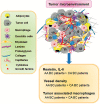Emerging evidence for the role of differential tumor microenvironment in breast cancer racial disparity: a closer look at the surroundings
- PMID: 28430867
- PMCID: PMC5862302
- DOI: 10.1093/carcin/bgx037
Emerging evidence for the role of differential tumor microenvironment in breast cancer racial disparity: a closer look at the surroundings
Abstract
Although increased awareness leading to early detection and prevention, as well as advancements in treatment strategies, have resulted in superior clinical outcomes, African American women with breast cancer continue to have greater mortality rates, compared to Caucasian American counterparts. Moreover, African American women are more likely to have breast cancer at a younger age and be diagnosed with aggressive tumor sub-types. Such racial disparities can be attributed to socioeconomic differences, but it is increasingly being recognized that these disparities may indeed be due to certain genetic and other non-genetic biological differences. Tumor microenvironment, which provides a favorable niche for the growth of tumor cells, is comprised of several types of stromal cells and the various proteins secreted as a consequence of bi-directional tumor-stromal cross-talk. Emerging evidence suggests inherent biological differences in the tumor microenvironment of breast cancer patients from different racial backgrounds. Tumor microenvironment components, affected by the genetic make-up of the tumor cells as well as other non-tumor-associated factors, may also render patients more susceptible to the development of aggressive tumors and faster progression of disease resulting in early onset, thus adversely affecting patients' survival. This review provides an overview of breast cancer racial disparity and discusses the existence of race-associated differential tumor microenvironment and its underlying genetic and non-genetic causal factors. A better understanding of these aspects would help further research on effective cancer management and improved approaches for reducing the racial disparities gaps in breast cancer patients.
© The Author 2017. Published by Oxford University Press. All rights reserved. For Permissions, please email: journals.permissions@oup.com.
Figures


References
-
- Siegel R.L., et al. (2015) Cancer statistics, 2015. CA. Cancer J. Clin., 65, 5–29. - PubMed
-
- DeSantis C.E., et al. (2016) Breast cancer statistics, 2015: Convergence of incidence rates between black and white women. CA. Cancer J. Clin., 66, 31–42. - PubMed
-
- American Cancer Society. Breast Cancer Facts and Figures 2011–2012 (2011). American Cancer Society, Atlanta, GA.
-
- Vona-Davis L., et al. (2009) The influence of socioeconomic disparities on breast cancer tumor biology and prognosis: a review. J. Womens. Health (Larchmt)., 18, 883–893. - PubMed
Publication types
MeSH terms
Grants and funding
LinkOut - more resources
Full Text Sources
Other Literature Sources
Medical

